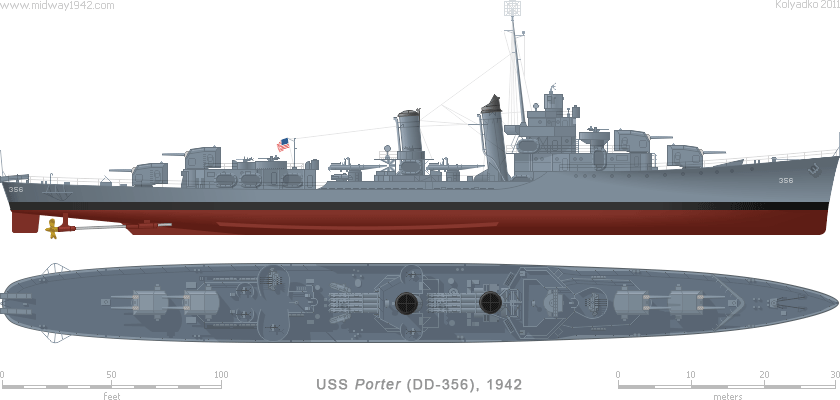
| Porter class | DESTROYER LEADERS | |

| Displacement: | 2,857 t (2,154 t Std) | Machinery: | 4 boilers, 2 shafts | SP Guns: | 4×2×5 in (127 mm)/38 | |||||||
|---|---|---|---|---|---|---|---|---|---|---|---|---|
| Max Length: | 381 ft 0 in | 116.1 m | Max Power: | 50,000 hp | 36 775 kW | AA Guns: | 2×4×1.1 in (28 mm) | |||||
| Beam: | 36 ft 2 in | 11.0 m | Max Speed: | 37 kts | 68.6 km/h | AA Guns: | 5×1×.79 in (20 mm) | |||||
| Draght: | 13 ft 9 in | 4.2 m | Range: | 6,500 nm | 12 000 km | Torpedo Battery: | 2×4×21 in (533 mm) | |||||
| Complement: | 194 officers & enlisted | Bunkerage: | 635 t fuel oil | Depth Charges: | 2 roller racks, 14 charges | |||||||
* Armament as during the Battle of Midway (June 1942).
The great number of U.S. destroyers and the total absence of light cruisers to lead them made the development of large destroyers or “destroyer leaders” the major concern of late World War I and postwar designers, but the first class of such ships—larger, than a destroyer, and carrying more powerful artillery to break through the enemy screen and allow the following destroyers to do likewise—was designed and funded in 1933 only.
Eight ships of the Porter class were, in effect, enlarged versions of the Farraguts, with a better machinery arrangement and an increased main battery. Heavy armament on a 1,850-ton displacement meant four twin 5 in (127 mm) guns, but no twin turret had been developed that could elevate above 35°. Thus, the new class entered life with the main armament of eight single-purpose guns. Like the Farraguts, the Porters mounted eight 21 in (533 mm) torpedo tubes in two quadruple centerline mounts. They could also carry eight torpedoes reloads in special containers abeam the after stack, although—as opposed to their Japanese opponents—reloading underway was awkward at best.
The anti-aircraft armament initially consisted of two quadruple 1.1 in (28 mm) autocannons and two .50 in (12.7 mm) machine guns, but by the beginning of the Pacific War, it became obvious that it is not enough to protect the ships from modern aircraft. In September 1941 was suggested that the Porters receive three 1.57 in (40 mm) Bofors twin mounts and four single .79 in (20 mm) Oerlikon autocannons in lieu of the old AA armament, but for lack of Boforses, the ships retained their 1.1 in (28 mm) autocannons during the first year of the war.
Two Porter class destroyers (DD-360 Phelps and DD-363 Balch) took part in the Battle of Midway as flagships of the Destroyer Squadrons 10 and 6, Task Force 16 Destroyer Screen (Task Group 16.4).
| Ship | Builder | Laid Down | Launched | Commisioned | Fate | |||||||||||||
|---|---|---|---|---|---|---|---|---|---|---|---|---|---|---|---|---|---|---|
| DD-356 | Porter | New York Shipbuilding Corp., NJ | 18 | Dec | 1933 | 12 | Dec | 1935 | 25 | Aug | 1936 | Sunk in action | 26 | Oct | 1942 | |||
| DD-357 | Selfridge | New York Shipbuilding Corp., NJ | 18 | Dec | 1933 | 18 | Apr | 1936 | 25 | Nov | 1936 | Sold for scrap | 20 | Dec | 1946 | |||
| DD-358 | McDougal | New York Shipbuilding Corp., NJ | 18 | Dec | 1933 | 17 | Jul | 1936 | 23 | Dec | 1936 | Sold for scrap | 2 | Aug | 1949 | |||
| DD-359 | Winslow | New York Shipbuilding Corp., NJ | 18 | Dec | 1933 | 21 | Sep | 1936 | 17 | Feb | 1937 | Sold for scrap | 23 | Feb | 1959 | |||
| DD-360 | Phelps | Bethlehem Steel Corp. Quincy, MA | 2 | Jan | 1934 | 18 | Jul | 1935 | 26 | Feb | 1936 | Sold for scrap | 10 | Aug | 1947 | |||
| DD-361 | Clark | Bethlehem Steel Corp. Quincy, MA | 2 | Jan | 1934 | 15 | Oct | 1935 | 20 | May | 1936 | Sold for scrap | 29 | Mar | 1946 | |||
| DD-362 | Moffett | Bethlehem Steel Corp. Quincy, MA | 2 | Jan | 1934 | 11 | Dec | 1935 | 28 | Aug | 1936 | Sold for scrap | 16 | May | 1947 | |||
| DD-363 | Balch | Bethlehem Steel Corp. Quincy, MA | 16 | May | 1934 | 24 | Mar | 1936 | 20 | Oct | 1936 | Sold for scrap | 29 | Mar | 1946 | |||